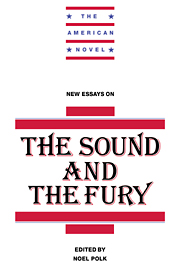Book contents
- Frontmatter
- Contents
- Series Editor's Preface
- 1 Introduction
- 2 Faulkner's Text Which Is Not One
- 3 “Now I Can Write”: Faulkner's Novel of Invention
- 4 Quentin Compson: Tyrrhenian Vase or Crucible of Race?
- 5 Trying Not to Say: A Primer on the Language of The Sound and the Fury
- Notes on Contributors
- Selected Bibliography
4 - Quentin Compson: Tyrrhenian Vase or Crucible of Race?
Published online by Cambridge University Press: 23 December 2009
- Frontmatter
- Contents
- Series Editor's Preface
- 1 Introduction
- 2 Faulkner's Text Which Is Not One
- 3 “Now I Can Write”: Faulkner's Novel of Invention
- 4 Quentin Compson: Tyrrhenian Vase or Crucible of Race?
- 5 Trying Not to Say: A Primer on the Language of The Sound and the Fury
- Notes on Contributors
- Selected Bibliography
Summary
FAULKNER'S postpublication statements about The Sound and the Fury swaddle the book in maidenheads: having shut his door on publishers he “began to write about a little girl” and to “manufacture [a] sister.” In a further analogy, for writing he cites the old Roman “who kept at his bedside a Tyrrhenian vase which he loved and the rim of which he wore slowly away with kissing it. I had made myself a vase, but I suppose I knew all the time that I could not live forever inside of it.” The vase is a crackable euphemism. In Flags in the Dust (1927), the manuscript whose rejection caused Faulkner to close his door, Horace Benbow makes a similar vessel: having learned to blow glass in Venice, he manufactures “a small chaste shape … not four inches high, fragile as a silver lily and incomplete.” He calls the vase Narcissa, for his sister, and is anatomically concise about the source of his skills: of Venetian glass workers, he notes, “They work in caves … down flights of stairs underground. You feel water seeping under your foot while you are reaching for the next step, and when you put your hand out to steady yourself against the wall, it's wet when you take it away. It feels just like blood.” Venice and vagina elide, even as vase and hymen cross.
The pervasiveness of the hymen is reaffirmed by Faulkner's accounts of the novel's source, which place the sexuality of small girls at the first as at the last.
- Type
- Chapter
- Information
- New Essays on The Sound and the Fury , pp. 99 - 138Publisher: Cambridge University PressPrint publication year: 1993

